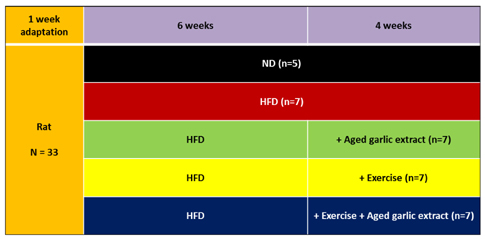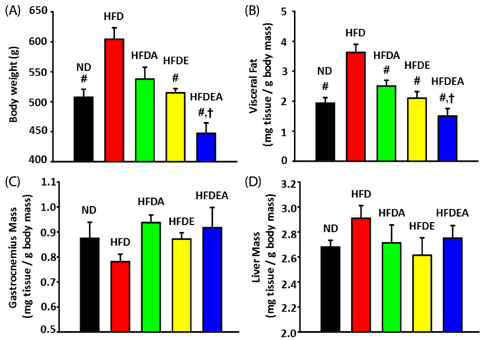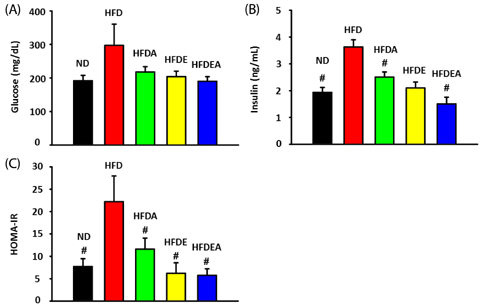Nutr Res Pract.
2014 Apr;8(2):177-182.
Effects of aged garlic extract and endurance exercise on skeletal muscle FNDC-5 and circulating irisin in high-fat-diet rat models
- Affiliations
-
- 1Department of Physiology, College of Medicine, Cardiovascular and Metabolic Disease Center, Inje University, Bokji-ro 75, Busanjin, Busan 633-165, Korea. phyhanj@inje.ac.kr
- 2Department of Kinesiology, Inha University, Incheon 402-751, Korea.
- 3Department of Physical Education, Pukyong National University, Busan 608-737, Korea.
- 4Division of Humanities and Social Science, POSTECH, Gyecngbuk 790-784, Korea.
- 5Division of Leisure & Sports Science, Dongseo University, Busan 617-716, Korea.
Abstract
- BACKGROUND/OBJECTIVES
Irisin, a newly identified hormone, is associated with energy homeostasis. We investigated whether aged garlic extract (AGE) and exercise training intervention could improve body weight, insulin sensitivity, skeletal muscle fibronectin domain containing protein 5 (FNDC-5) levels, and plasma irisin in high-fat diet (HFD).
MATERIALS/METHODS
Male Sprague Dawley rats were fed a ND (normal diet, n = 5) or HFD (n = 28) for 6 weeks. After 6 weeks, all rats were divided into 5 groups for the next 4 weeks: ND, (normal diet, n = 5), HFD (high-fat diet, n = 7), HFDA (high-fat diet + aged garlic extract, n = 7), HFDE (high-fat diet + exercise, n = 7), and HFDEA (high-fat diet + exercise + aged garlic extract, n = 7). Exercise groups performed treadmill exercises for 15-60 min, 5 days/week, and AGE groups received AGE (2.86 g/kg, orally injected) for 4 weeks.
RESULTS
Significant decreases in body weight were observed in the ND, HFDE, and HFDEA groups, as compared with the HFD group. Neither intervention affected the masses of the gastrocnemius muscle or liver. There were no significant differences in glucose levels across the groups. The homeostatic model assessments of insulin resistance were significantly higher in the HFD group, as compared with the ND, HFDA, HFDE, and HFDEA groups. However, skeletal muscle FNDC-5 levels and plasma irisin concentrations were unaffected by AGE or exercise in obese rats. AGE supplementation and exercise training did not affect skeletal muscle FNDC-5 or plasma irisin, which are associated with insulin sensitivity in obese rats.
CONCLUSION
Our results suggest that the protection against HFD-induced increases in body fat/weight and insulin resistance that are provided by AGE supplementation and exercise training may not be mediated by the regulation of FNDC-5 or irisin.
MeSH Terms
Figure
Reference
-
1. Blair SN, Brodney S. Effects of physical inactivity and obesity on morbidity and mortality: current evidence and research issues. Med Sci Sports Exerc. 1999; 31:S646–S662.
Article2. Yang M, Li Y, Zhang R. Effect of intermittent versus continuous exercise on obesity and fatty liver in rats fed with high-fat diet. Nan Fang Yi Ke Da Xue Xue Bao. 2013; 33:61–65.3. Miller WC, Bryce GR, Conlee RK. Adaptations to a high-fat diet that increase exercise endurance in male rats. J Appl Physiol Respir Environ Exerc Physiol. 1984; 56:78–83.
Article4. Touati S, Meziri F, Devaux S, Berthelot A, Touyz RM, Laurant P. Exercise reverses metabolic syndrome in high-fat diet-induced obese rats. Med Sci Sports Exerc. 2011; 43:398–407.
Article5. Seo DY, Lee S, Figueroa A, Kwak YS, Kim N, Rhee BD, Ko KS, Bang HS, Baek YH, Han J. Aged garlic extract enhances exercise-mediated improvement of metabolic parameters in high fat diet-induced obese rats. Nutr Res Pract. 2012; 6:513–519.
Article6. Niederdeppe J, Roh S, Shapiro MA, Kim HK. Effects of messages emphasizing environmental determinants of obesity on intentions to engage in diet and exercise behaviors. Prev Chronic Dis. 2013; 10:E209.
Article7. Fock KM, Khoo J. Diet and exercise in management of obesity and overweight. J Gastroenterol Hepatol. 2013; 28:Suppl 4. 59–63.
Article8. Johansson K, Neovius M, Hemmingsson E. Effects of anti-obesity drugs, diet, and exercise on weight-loss maintenance after a very-low-calorie diet or low-calorie diet: a systematic review and meta-analysis of randomized controlled trials. Am J Clin Nutr. 2014; 99:14–23.
Article9. Colín-González AL, Santana RA, Silva-Islas CA, Chánez-Cárdenas ME, Santamaría A, Maldonado PD. The antioxidant mechanisms underlying the aged garlic extract- and S-allylcysteine-induced protection. Oxid Med Cell Longev. 2012; 2012:907162.
Article10. Morihara N, Sumioka I, Ide N, Moriguchi T, Uda N, Kyo E. Aged garlic extract maintains cardiovascular homeostasis in mice and rats. J Nutr. 2006; 136:777S–781S.
Article11. Seo DY, Lee SR, Kim HK, Baek YH, Kwak YS, Ko TH, Kim N, Rhee BD, Ko KS, Park BJ, Han J. Independent beneficial effects of aged garlic extract intake with regular exercise on cardiovascular risk in postmenopausal women. Nutr Res Pract. 2012; 6:226–231.
Article12. Park HJ, Jeon BT, Kim HC, Roh GS, Shin JH, Sung NJ, Han J, Kang D. Aged red garlic extract reduces lipopolysaccharide-induced nitric oxide production in RAW 264.7 macrophages and acute pulmonary inflammation through haeme oxygenase-1 induction. Acta Physiol (Oxf). 2012; 205:61–70.
Article13. Ried K, Frank OR, Stocks NP. Aged garlic extract lowers blood pressure in patients with treated but uncontrolled hypertension: a randomised controlled trial. Maturitas. 2010; 67:144–150.
Article14. Wang X, Jiao F, Wang QW, Wang J, Yang K, Hu RR, Liu HC, Wang HY, Wang YS. Aged black garlic extract induces inhibition of gastric cancer cell growth in vitro and in vivo. Mol Med Rep. 2012; 5:66–72.15. Ueta CB, Olivares EL, Bianco AC. Responsiveness to thyroid hormone and to ambient temperature underlies differences between brown adipose tissue and skeletal muscle thermogenesis in a mouse model of diet-induced obesity. Endocrinology. 2011; 152:3571–3581.
Article16. Johansen T, Richelsen B, Hansen HS, Din N, Malmlöf K. Growth hormone-mediated breakdown of body fat: effects of GH on lipases in adipose tissue and skeletal muscle of old rats fed different diets. Horm Metab Res. 2003; 35:243–250.
Article17. Moreno-Navarrete JM, Ortega F, Serrano M, Guerra E, Pardo G, Tinahones F, Ricart W, Fernández-Real JM. Irisin is expressed and produced by human muscle and adipose tissue in association with obesity and insulin resistance. J Clin Endocrinol Metab. 2013; 98:E769–E778.
Article18. Luo LJ, Zhang J. A novel myokin: Irisin. Sheng Li Ke Xue Jin Zhan. 2013; 44:111–114.19. Roca-Rivada A, Castelao C, Senin LL, Landrove MO, Baltar J, Belén Crujeiras A, Seoane LM, Casanueva FF, Pardo M. FNDC5/irisin is not only a myokine but also an adipokine. PLoS One. 2013; 8:e60563.
Article20. Boström P, Wu J, Jedrychowski MP, Korde A, Ye L, Lo JC, Rasbach KA, Boström EA, Choi JH, Long JZ, Kajimura S, Zingaretti MC, Vind BF, Tu H, Cinti S, Højlund K, Gygi SP, Spiegelman BM. A PGC1-alpha-dependent myokine that drives brown-fat-like development of white fat and thermogenesis. Nature. 2012; 481:463–468.
Article21. Cunha A. Basic research: Irisin--behind the benefits of exercise. Nat Rev Endocrinol. 2012; 8:195.22. Roberts MD, Bayless DS, Company JM, Jenkins NT, Padilla J, Childs TE, Martin JS, Dalbo VJ, Booth FW, Rector RS, Laughlin MH. Elevated skeletal muscle irisin precursor FNDC5 mRNA in obese OLETF rats. Metabolism. 2013; 62:1052–1056.
Article23. Elbelt U, Hofmann T, Stengel A. Irisin: what promise does it hold? Curr Opin Clin Nutr Metab Care. 2013; 16:541–547.24. Sanchis-Gomar F, Lippi G, Mayero S, Perez-Quilis C, García-Giménez JL. Irisin: a new potential hormonal target for the treatment of obesity and type 2 diabetes. J Diabetes. 2012; 4:196.
Article25. Polyzos SA, Kountouras J, Shields K, Mantzoros CS. Irisin: a renaissance in metabolism? Metabolism. 2013; 62:1037–1044.
Article26. Choi YK, Kim MK, Bae KH, Seo HA, Jeong JY, Lee WK, Kim JG, Lee IK, Park KG. Serum irisin levels in new-onset type 2 diabetes. Diabetes Res Clin Pract. 2013; 100:96–101.
Article27. Liu JJ, Wong MD, Toy WC, Tan CS, Liu S, Ng XW, Tavintharan S, Sum CF, Lim SC. Lower circulating irisin is associated with type 2 diabetes mellitus. J Diabetes Complications. 2013; 27:365–369.
Article28. Boor P, Celec P, Behuliak M, Grancic P, Kebis A, Kukan M, Pronayová N, Liptaj T, Ostendorf T, Sebeková K. Regular moderate exercise reduces advanced glycation and ameliorates early diabetic nephropathy in obese Zucker rats. Metabolism. 2009; 58:1669–1677.
Article29. Morihara N, Ushijima M, Kashimoto N, Sumioka I, Nishihama T, Hayama M, Takeda H. Aged garlic extract ameliorates physical fatigue. Biol Pharm Bull. 2006; 29:962–966.
Article30. Farias JM, Maggi RM, Tromm CB, Silva LA, Luciano TF, Marques SO, Lira FS, de Souza CT, Pinho RA. Exercise training performed simultaneously to a high-fat diet reduces the degree of insulin resistance and improves adipoR1-2/APPL1 protein levels in mice. Lipids Health Dis. 2012; 11:134.
Article31. Højlund K, Boström P. Irisin in obesity and type 2 diabetes. J Diabetes Complications. 2013; 27:303–304.
Article32. Shaodong C, Haihong Z, Manting L, Guohui L, Zhengxiao Z, Y M Z. Research of influence and mechanism of combining exercise with diet control on a model of lipid metabolism rat induced by high fat diet. Lipids Health Dis. 2013; 12:21.
Article33. Kong LC, Wuillemin PH, Bastard JP, Sokolovska N, Gougis S, Fellahi S, Darakhshan F, Bonnefont-Rousselot D, Bittar R, Doré J, Zucker JD, Clément K, Rizkalla S. Insulin resistance and inflammation predict kinetic body weight changes in response to dietary weight loss and maintenance in overweight and obese subjects by using a Bayesian network approach. Am J Clin Nutr. 2013; 98:1385–1394.
Article34. Everard A, Geurts L, Van Roye M, Delzenne NM, Cani PD. Tetrahydro iso-alpha acids from hops improve glucose homeostasis and reduce body weight gain and metabolic endotoxemia in high-fat diet-fed mice. PLoS One. 2012; 7:e33858.
Article35. Baile CA, Yang JY, Rayalam S, Hartzell DL, Lai CY, Andersen C, Della-Fera MA. Effect of resveratrol on fat mobilization. Ann N Y Acad Sci. 2011; 1215:40–47.
Article36. Gouni-Berthold I, Berthold HK, Huh JY, Berman R, Spenrath N, Krone W, Mantzoros CS. Effects of lipid-lowering drugs on irisin in human subjects in vivo and in human skeletal muscle cells ex vivo. PLoS One. 2013; 8:e72858.
Article37. Boström PA, Fernández-Real JM. Metabolism: Irisin, the metabolic syndrome and follistatin in humans. Nat Rev Endocrinol. 2014; 10:11–12.
Article38. Swick AG, Orena S, O'Connor A. Irisin levels correlate with energy expenditure in a subgroup of humans with energy expenditure greater than predicted by fat free mass. Metabolism. 2013; 62:1070–1073.
Article39. Kraemer RR, Shockett P, Webb ND, Shah U, Castracane VD. A transient elevated irisin blood concentration in response to prolonged, moderate aerobic exercise in young men and women. Horm Metab Res. 2014; 46:150–154.
Article40. Huh JY, Panagiotou G, Mougios V, Brinkoetter M, Vamvini MT, Schneider BE, Mantzoros CS. FNDC5 and irisin in humans: I. Predictors of circulating concentrations in serum and plasma and II. mRNA expression and circulating concentrations in response to weight loss and exercise. Metabolism. 2012; 61:1725–1738.
Article41. Timmons JA, Baar K, Davidsen PK, Atherton PJ. Is irisin a human exercise gene? Nature. 2012; 488:E9–10.
Article
- Full Text Links
- Actions
-
Cited
- CITED
-
- Close
- Share
- Similar articles
-
- Effects of Endurance Exercise and High-Fat Diet on Insulin Resistance and Ceramide Contents of Skeletal Muscle in Sprague-Dawley Rats
- Resistance exercise training‑induced skeletal muscle strength provides protective effects on high‑fat‑diet‑induced metabolic stress in mice
- Effect of exercise and diet intervention on endoplasmic reticulum (ER) stress in rat skeletal muscle and adipose tissue
- Myokines and interorgan crosstalk: bridging exercise to health promotion and disease prevention
- Effect of Exercise Training on Insulin Sensitivity and Intracellular Glucose Metabolism in Skeletal Muscle of High Fat-fed Rats





